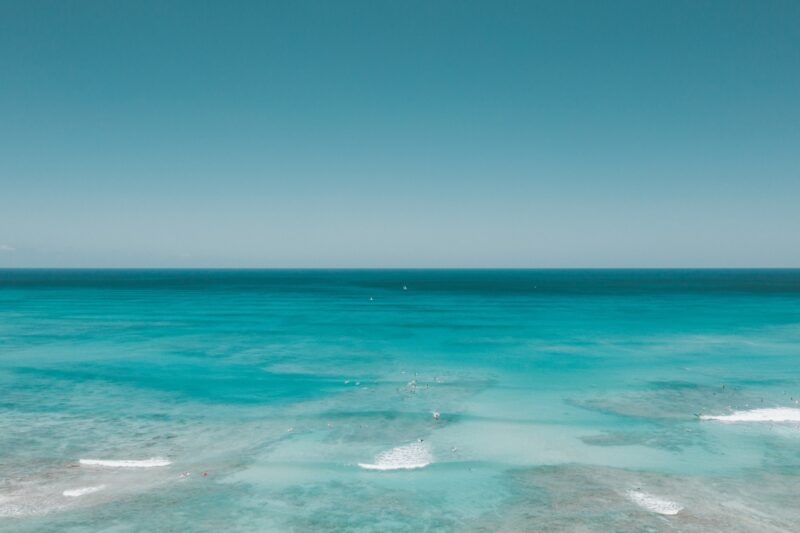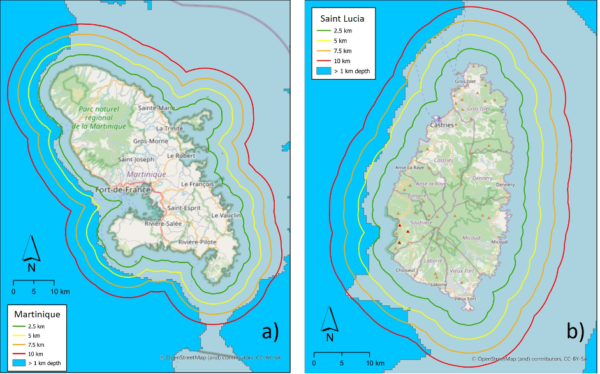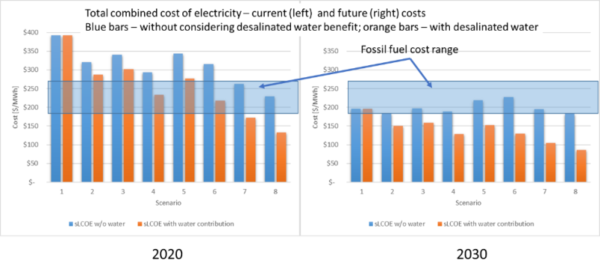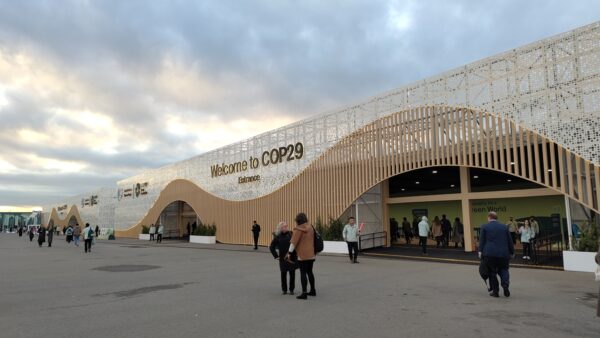Ocean thermal energy conversion – what is it and what role could it play for Small Island States in the Caribbean?
Using Geographical Information Systems tools, we have determined where water depth and proximity to shore could provide a site for ocean thermal energy conversion installation for all islands in the Caribbean. But this technology is still the poor cousin in the renewables family, leading many to ask – what is ocean thermal energy conversion and what can it bring to the table to support a 100% renewable electricity system?
Share

In the Caribbean, Small Island Developing States (SIDS) are bathed in sunshine and wind, and surrounded by the ocean. However, despite this abundant potential for renewables, their electricity systems are dominated by imported diesel fuel.
Electricity costs to consumers in the Caribbean region are among the highest in the world, mainly because of this dependence on diesel generators. Couple that with the dramatic drop in the cost of power generation from solar photovoltaics and wind turbines in the past decade, and it would seem that the time is ripe for energy system transformation.
Multiple other factors support the argument for a switch to renewable energy. Compared to countries in colder climates, the Caribbean has little seasonal variability, with no requirement for winter space heating during times of low sunshine.
SIDS have also been among the most vocal proponents of meeting the Paris Agreement 1.5°C temperature goal, with good reason: they are also among the most vulnerable countries in the world to climate change impacts.
And yet despite this, uptake of renewables has been relatively slow.
Dispatchable renewables for SIDS
The integration of variable renewable energy, like solar and wind, requires controllable (‘dispatchable’) sources of power. Or to be able to store energy. Or both.
Although battery storage has become much cheaper in recent years, maintaining system reliability is easier if there is also some other source of flexible power generation like hydropower, biomass and waste for electricity, geothermal power, wave and tidal energy – and ocean thermal energy conversion.
Each of these technologies has its limitations and advantages. For Caribbean Islands, the calculus is simple, and mainly dictated by availability – for example only a few islands have significant hydropower potential. Geothermal power is also under active exploration in the region, but only Guadeloupe already has installed capacity.
What is ocean thermal energy conversion?
Ocean thermal energy conversion (OTEC) is the process of extracting energy from the difference in temperature between surface and deep water. The concept was first proposed in the 1880s and the first working power plant was built – in Cuba in 1930, with additional demonstration units built periodically since then.
OTEC hasn’t caught on in a big way due to relatively high costs and the limitation that it can only be implemented in regions where there are year-round warm sea surface temperatures and cold, deep water near a shoreline. Currently there are two operating OTEC plants worldwide – in Hawaii – with more in the planning stages.
Most conventional sources of electricity make use of energy sources at high temperatures (like in combustion of fossil fuels) to extract energy before dumping waste heat into the surrounding air or water. They use the principle of a thermodynamic ‘heat engine’ where usually the aim is to have a very high temperature (combustion) and then use ambient air or water as the lower temperature. The greater the difference in temperature, the more efficient the system.
In the case of OTEC, the need for a big temperature difference is balanced by the essentially infinite reservoirs of ocean water that can act as free fuel, so the low efficiency due to an average temperature difference of only 20°C is not as important.
Where can ocean thermal energy conversion be applied?
In a recent paper we have, for the first time, used Geographical Information Systems (GIS) tools to determine where water depth and proximity to shore could provide a site for OTEC installation for all islands in the Caribbean. Beyond that, we identified where existing towns or other infrastructure coincided with the promising deep-water conditions.
In our paper we were able to show that, based on reasonable assumptions about current and future costs of technologies and of storage, OTEC could be combined with wind and solar power to generate electricity more cheaply than existing fossil fuel-based systems.

The Caribbean Islands are in a strong position to be the test bed for scaling up OTEC. This technology can help support the system integration of high penetrations of variable renewable energy sources such as wind and solar.
The particular configuration of OTEC we considered in our paper also results in condensed water that is desalinated – a no cost co-benefit of the process that is also of great interest to many islands, where fresh water resources are threatened by rising sea levels.
There are also proposals for sea water district cooling – where the cool ocean water that is circulating in the system can be used as a source for cooling buildings, providing an efficient and low-cost way to tackle cooling demand without using extra electricity – also of great interest for tropical regions.
OTEC will never become a mass-market technology that will scale up to generate large amounts of electricity capacity globally, simply because of the geographical limitations. However, there are countries in the Caribbean and elsewhere in the world – such as the Pacific – where other dispatchable forms of energy, like hydropower or geothermal power aren’t suitable, and where OTEC could be used to complement wind and solar energy to achieve a 100% renewable energy system.













